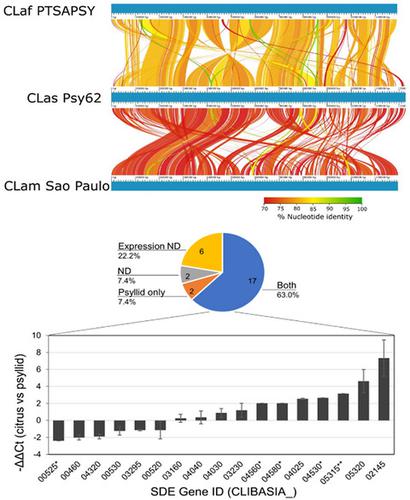当前位置:
X-MOL 学术
›
Mol. Plant Pathol.
›
论文详情
Our official English website, www.x-mol.net, welcomes your feedback! (Note: you will need to create a separate account there.)
Genome-wide analyses of Liberibacter species provides insights into evolution, phylogenetic relationships, and virulence factors.
Molecular Plant Pathology ( IF 4.9 ) Pub Date : 2020-02-28 , DOI: 10.1111/mpp.12925 Shree P Thapa 1 , Agustina De Francesco 2 , Jessica Trinh 2 , Fatta B Gurung 3 , Zhiqian Pang 4 , Georgios Vidalakis 2 , Nian Wang 4 , Veronica Ancona 3 , Wenbo Ma 2 , Gitta Coaker 1
Molecular Plant Pathology ( IF 4.9 ) Pub Date : 2020-02-28 , DOI: 10.1111/mpp.12925 Shree P Thapa 1 , Agustina De Francesco 2 , Jessica Trinh 2 , Fatta B Gurung 3 , Zhiqian Pang 4 , Georgios Vidalakis 2 , Nian Wang 4 , Veronica Ancona 3 , Wenbo Ma 2 , Gitta Coaker 1
Affiliation

|
‘Candidatus Liberibacter’ species are insect‐transmitted, phloem‐limited α‐Proteobacteria in the order of Rhizobiales. The citrus industry is facing significant challenges due to huanglongbing, associated with infection from ‘Candidatus Liberibacter asiaticus’ (Las). In order to gain greater insight into ‘Ca. Liberibacter’ biology and genetic diversity, we have performed genome sequencing and comparative analyses of diverse ‘Ca. Liberibacter’ species, including those that can infect citrus. Our phylogenetic analysis differentiates ‘Ca. Liberibacter’ species and Rhizobiales in separate clades and suggests stepwise evolution from a common ancestor splitting first into nonpathogenic Liberibacter crescens followed by diversification of pathogenic ‘Ca. Liberibacter’ species. Further analysis of Las genomes from different geographical locations revealed diversity among isolates from the United States. Our phylogenetic study also indicates multiple Las introduction events in California and spread of the pathogen from Florida to Texas. Texan Las isolates were closely related, while Florida and Asian isolates exhibited the most genetic variation. We have identified conserved Sec translocon (SEC)‐dependent effectors likely involved in bacterial survival and virulence of Las and analysed their expression in their plant host (citrus) and insect vector (Diaphorina citri). Individual SEC‐dependent effectors exhibited differential expression patterns between host and vector, indicating that Las uses its effector repertoire to differentially modulate diverse organisms. Collectively, this work provides insights into the evolution of ‘Ca. Liberibacter’ species, the introduction of Las in the United States and identifies promising Las targets for disease management.
中文翻译:

对利比里亚细菌进行全基因组分析可深入了解进化,系统发育关系和毒力因子。
' Candidatus Liberibacter'种类是根瘤菌顺序的昆虫传播,韧皮部限制的α-变形杆菌。柑橘产业正面临着由于黄龙显著挑战,从感染“相关的暂定Liberibacter胭脂”(拉斯维加斯)。为了深入了解' Ca。Liberibacter的生物学和遗传多样性,我们已经完成了多种Ca的基因组测序和比较分析。Liberibacter的物种,包括那些可以感染柑橘的物种。我们的系统发育分析可以区分' Ca。利比里亚细菌的种类和根瘤菌在不同的进化枝中,提示从共同祖先开始逐步进化成非致病性的渐进性渐增丽,然后致病性Ca多样化。Liberibacter的物种。来自不同地理位置的Las基因组的进一步分析揭示了来自美国的分离株之间的多样性。我们的系统发育研究还表明,在加利福尼亚发生了多次Las引入事件,病原体从佛罗里达传播到了得克萨斯州。德克萨斯州拉斯分离株密切相关,而佛罗里达和亚洲分离株表现出最大的遗传变异。我们已经确定了保守的Sec translocon(SEC)依赖效应子,可能与Las的细菌存活和毒力有关,并分析了它们在植物宿主(柑橘)和昆虫载体中的表达(柑橘木虱)。单个依赖于SEC的效应子在宿主和载体之间表现出差异表达模式,这表明Las使用其效应子库来差异调节多种生物。总的来说,这项工作提供了有关Ca进化的见解。Liberibacter的物种,在美国引入Las,并确定了有希望的Las疾病管理目标。
更新日期:2020-02-28
中文翻译:

对利比里亚细菌进行全基因组分析可深入了解进化,系统发育关系和毒力因子。
' Candidatus Liberibacter'种类是根瘤菌顺序的昆虫传播,韧皮部限制的α-变形杆菌。柑橘产业正面临着由于黄龙显著挑战,从感染“相关的暂定Liberibacter胭脂”(拉斯维加斯)。为了深入了解' Ca。Liberibacter的生物学和遗传多样性,我们已经完成了多种Ca的基因组测序和比较分析。Liberibacter的物种,包括那些可以感染柑橘的物种。我们的系统发育分析可以区分' Ca。利比里亚细菌的种类和根瘤菌在不同的进化枝中,提示从共同祖先开始逐步进化成非致病性的渐进性渐增丽,然后致病性Ca多样化。Liberibacter的物种。来自不同地理位置的Las基因组的进一步分析揭示了来自美国的分离株之间的多样性。我们的系统发育研究还表明,在加利福尼亚发生了多次Las引入事件,病原体从佛罗里达传播到了得克萨斯州。德克萨斯州拉斯分离株密切相关,而佛罗里达和亚洲分离株表现出最大的遗传变异。我们已经确定了保守的Sec translocon(SEC)依赖效应子,可能与Las的细菌存活和毒力有关,并分析了它们在植物宿主(柑橘)和昆虫载体中的表达(柑橘木虱)。单个依赖于SEC的效应子在宿主和载体之间表现出差异表达模式,这表明Las使用其效应子库来差异调节多种生物。总的来说,这项工作提供了有关Ca进化的见解。Liberibacter的物种,在美国引入Las,并确定了有希望的Las疾病管理目标。



























 京公网安备 11010802027423号
京公网安备 11010802027423号